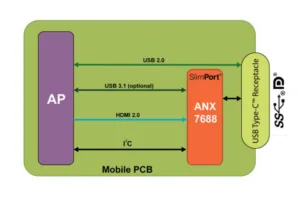On the evening before the main exhibition start, Pepcom held its MobileFocus event. The big attraction for the press that evening in Barcelona was the Samsung press event and that meant a relatively low turnout of journalists at MobileFocus, at least in the earlier part of the evening before the buses from Samsung’s event arrived. It did mean more time for us to talk to vendors.
Analogix had no news at the event, but did tell us that it had got a design win for its display interface chips in the LG G5. Of course, the next day, the firm announced its new ANX7688 chip which is designed to enable USB Type-C ports on smartphones, with support for resolutions up to 4096 x 2160 p60 or 1920 x 180 at P120, which is ideal for AR and VR applications needing dual displays. The chip is sampling now and the firm thinks it is “years ahead” of its competitors in this area and will be in mass production in Q2 2016.
Atheer was promoting its A/R glasses which were not entirely new at the event and which use 720P resolution and exploit the Lumus optical technology. The glasses supports 50º FOV and run Atheer’s own O/S. Of course, the glasses are intended for professional applications at the moment. One of the limitations of this kind of system, at the moment, is that it needs a lot of power (the system uses a Tegra K1 processor which has serious computing power) and that can mean a couple of batteries being needed for a full day’s operation. The batteries can be hot-swapped.The Atheer Air headset will be available “soon” and will cost $3.950.
The firm was also showing its AirSuite for Enterprise software system which can also be used with other hardware (e.g. Vuzix). Atheer has an “Air Designer” development system that makes building applications a matter of “drag and drop” operations. The company is also working on software to enable and improve conferencing and collaboration with headsets.
Dell was showing a new product in its Latititude line, the 7370 which is “XPS” style, using a carbon fibre case, the company told us, and is intended for professional users, so it includes 4G connectivity and V-Pro support for enhanced security as well as being tested to MIL-Spec 810. The product was first shown at CES, but it passed us by in the flood! The notebook uses a 13.3″ display which is available in 1920 x 1080 or 3200 x 1800 touch display. The processors are from the CoreM range and there is up to 16GB of RAM and 512GB of SDSD. Of course, we looked at the display outputs and there are dual USB Type-C ports with Thunderbolt 3 compatibility as well as a mini-HDMI. Dell has also developed new docks that can charge the notebook through the Type-C port and there is also a new Thunderbolt dock that can support dual UltraHD monitors or more FullHD displays.
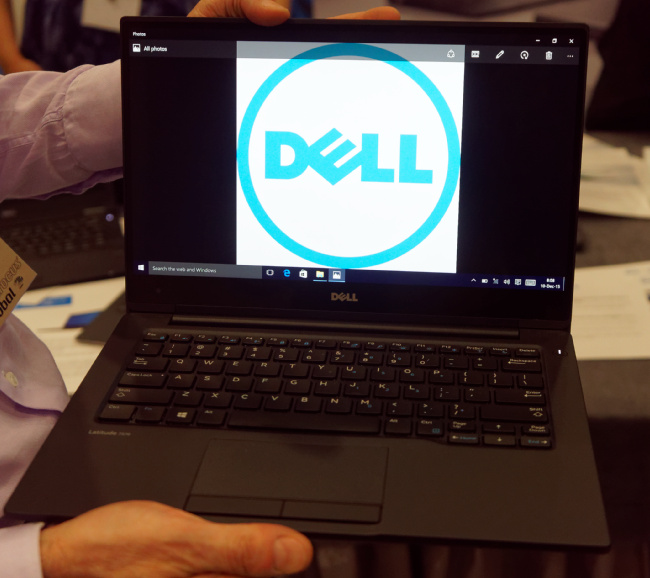
Garmin was showing its latest GPS systems and we looked at the Varia Vision display which it has designed for cyclists. The unit connects to a Garmin GPS by bluetooth and will show data from the firm’s GPS systems. Garmin designed the system as an add-on as cyclists can be very picky about their choice of sunglasses and the Garmin has been widely praised as very adjustable and flexible in matching different glasses. The Garmin is designed to simulate a 16″ monitor at around 2m viewing distance and the display is small, but sharp and clear, with 428 x 240 resolution and waterproof to IPX7. We managed to get an image from the headset, although because the focal point is quite a long way behind the viewer, so the housing is way out of focus. The image quality is quite bright and sharp and our managing editor told us that he would be adding the viewer to his present list if a) he had time to get out on his bike (too much time spent writing newsletters!) and b) the price was a bit less!

Kyocera was showing its rugged phones and told us that it is the market leader in the US “push to talk” market. The company is working with SunPartner on using the French company’s transparent solar cell technology on its mobiles. (SunPartner Boosts Mobile Power Using Solar)
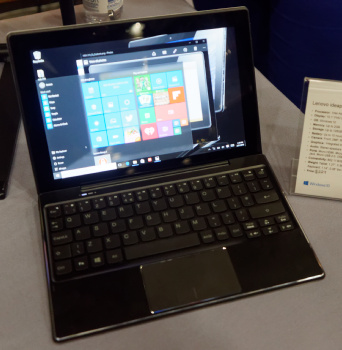 Lenovo’s Miix 310Lenovo had lots to show and we started by looking at the Yoga 710, Lenovo’s versatile convertible. The 710 is based on an aluminium/magnesium case and uses an Intel CoreM G5 processor in the 11″ configuration which starts at $499. It has two versions, an 11″ and a 14″ both with 1920 x 1080 IPS display, up to 8GB of DDR4 RAM and up to 256GB of SSD storage. There is an optional Nvidia GeForce 940MX graphics adaptor and a micro-HDMI and DisplayPort outputs and the 14″ version uses Skylake Core-i processors and costs from $799.
Lenovo’s Miix 310Lenovo had lots to show and we started by looking at the Yoga 710, Lenovo’s versatile convertible. The 710 is based on an aluminium/magnesium case and uses an Intel CoreM G5 processor in the 11″ configuration which starts at $499. It has two versions, an 11″ and a 14″ both with 1920 x 1080 IPS display, up to 8GB of DDR4 RAM and up to 256GB of SSD storage. There is an optional Nvidia GeForce 940MX graphics adaptor and a micro-HDMI and DisplayPort outputs and the 14″ version uses Skylake Core-i processors and costs from $799.
The Miix 310 is a “convertible” PC with a 10″ FullHD display and running Windows 10 on an Intel Atom platform. The system is in the ideapad range and has 2GB of memory and integrated graphics. The key point for this system is the price which is just $229, putting the system close to Chromebook territory.
The Lenovo Tab3 8 is an 8″ (800 x 1280) IPS tablet that uses a MediaTek 1.0GHz quad core processor, with 1GB of RM and 16GB of flash. Cameras are 2MP and 5MP and battery life is said to be 8 hours. The tablet is available at $99 for the Wi-fi only model and $129 for the LTE (although we spotted $149 on the spec that was shown). The tablet should be available in June.
The Tab3 7 has a 7″ 600 x 1024 display and just 8GB of flash in the base version. It is IP52 certified and Lenovo highlighted to us that the tablet has a “kids” mode and that is likely to be a target market for the firm. Pricing will be $129 for the 16GB version.
The Tab3 10 Biz will be available at the same time and uses a 10.1″ FullHD display with Android for Work, 2GB as standard (3GB max) and 32GB of flash and a microSD slot. Battery capacity is 7000mAH to allow up to 12 hours of use and it is IP52 certified. There is an LTE option, which adds $50 to the base model at $199. The front glass is Gorilla Glass 3.
On its booth, Lenovo showed the Ant VR, “Designed by Lenovo”, VR holder for the the firm’s 5″ to 6″ smartphones. The unit does not block light from the side of the display, but is light. The Ant VR started on kickstarter, but after a successful launch, has now moved off the platform. The holder costs Yuan 149 (around $22).

On its booth, the main point to note was that the company had an area devoted to demonstrating its stand alone and embedded pico projectors.
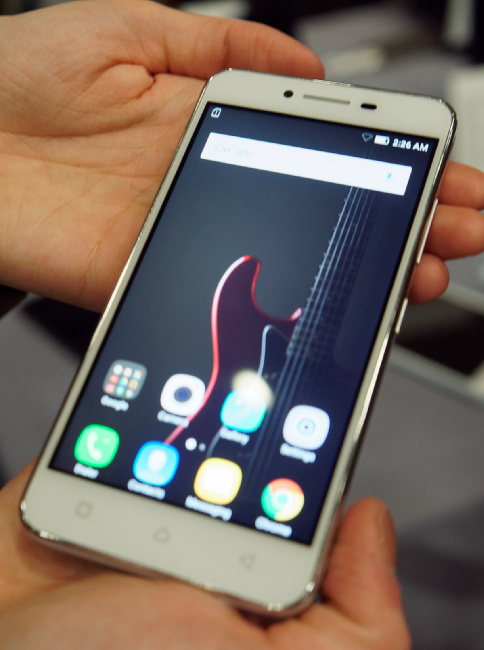 Lenovo’s Vibe K5 Looks good for a $129 product with Dual Sim support
Lenovo’s Vibe K5 Looks good for a $129 product with Dual Sim support
Turning to phones, K5 and K5 Plus are two new 5″ Android-based models in the Vibe range based on the Snapdragon 415 Octacore processor. The K5 has a 1280 x 720 display and the K5 Plus has a fullHD display. The OS is Android 5.1 and both have 13MP cameras on the back, 5MP on the front. RAM capacity is 2GB and 16GB flash with up to 32GB using microSD. A feature is the inclusion of dual sims. The Vibe range was premium but is now being aimed at the mass market and the phone will sell from $129.
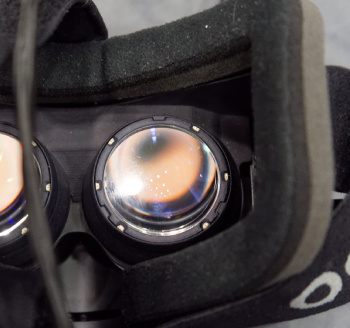 SMI is a German developer of gaze recognition systems. It is following the big push to “foveated rendering”, that is, identifying where the user of a VR system is looking and using that information to optimise the rendering of the image. This is important in VR applications where the power needed to drive dual displays means a lot of computing and GPU power being needed. The company already has reference designs available for its standard gaze systems and was also showing some prototypes of gaze trackers for the GearVR and the Oculus Rift. These use detectors around the outside of the lenses in the headsets. Compared to the early demonstration that we saw from The Eye Tribe (Showstoppers Reveals Projection Tablet and Phones), the SMI software was better at masking that foveated rendering was going on. The company told us that it already has around 100,000 users of its technology in A/R applications.
SMI is a German developer of gaze recognition systems. It is following the big push to “foveated rendering”, that is, identifying where the user of a VR system is looking and using that information to optimise the rendering of the image. This is important in VR applications where the power needed to drive dual displays means a lot of computing and GPU power being needed. The company already has reference designs available for its standard gaze systems and was also showing some prototypes of gaze trackers for the GearVR and the Oculus Rift. These use detectors around the outside of the lenses in the headsets. Compared to the early demonstration that we saw from The Eye Tribe (Showstoppers Reveals Projection Tablet and Phones), the SMI software was better at masking that foveated rendering was going on. The company told us that it already has around 100,000 users of its technology in A/R applications.
The first people that we spoke to at the event were the USB Implementors’ Forum who were showing USB Type-C developments. There were demonstrations of phones charging other phones and docking applications. As we forecast after discussions at CES, Samsung did not announce Type-C on the S7 smartphone, which was something of a shame for the Forum. However, we would expect the S8 to adopt the technology.
Vefxi was showing its new chip which is designed to automatically create stereo 3D from 2D content, without human intervention. The company told us that the chip uses a “neural network” (based on AI work) which is a different approach to that used by other companies. There is no traditional processor and no external memory is needed to support the conversion operation. The company’s CEO, Craig Peterson is a veteran of Intel and it was founded in December 2010. As we have reported in several articles over the last year, the firm has been winning some supporters.
The chip is designed to work on any device “from mobile to LED walls” and the company sees a a lot of possibilities for a conversion box to allow, for example, advertising content in cinemas to be converted to S3D. It has developed a box that is for home theatre use that will sell for $199.
Analyst Comment
Our notes said that performance of the conversion was “surprisingly good”, although we tend to be sceptical about short trade show demonstrations! The firm told us that one advantage of its chips is low latency which is said to be less than one frame. (BR)
Zeiss was showing the latest prototype version of its “smart glasses” optical system at the event and told us that it has adopted glass for the lenses which can be supplied to match optical prescriptions. The image is moved through the glass using TIR and then output by a fresnel lens. Zeiss has New AR Waveguide Technology
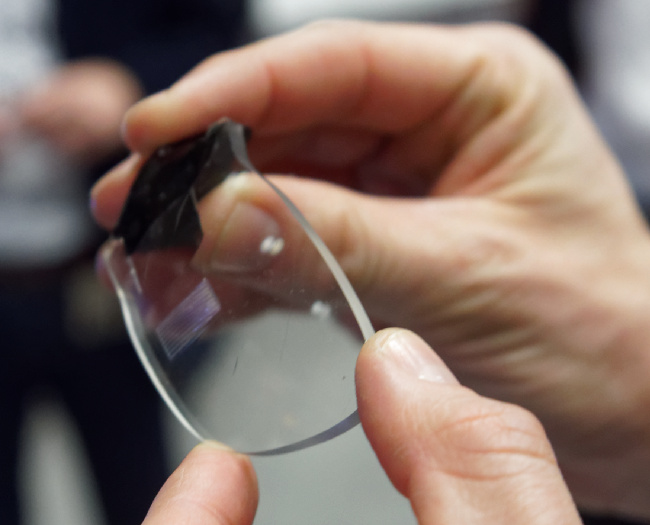 The Zeiss lens system is for AR glasses
The Zeiss lens system is for AR glasses

